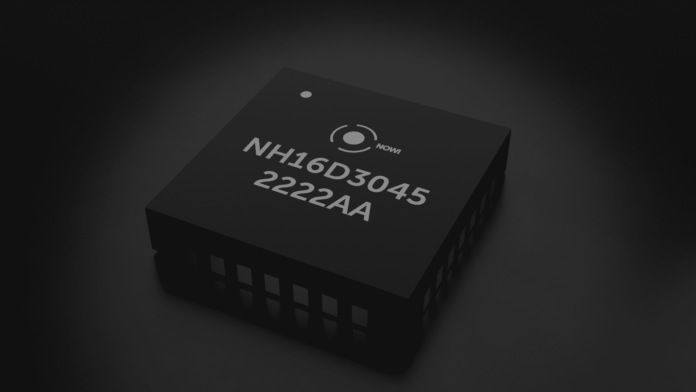Dutch semiconductor manufacturer Nowi, a specialist in energy-harvesting IoT chips, has introduced a new chipset with extended energy harvesting and power management capabilities. The new product, called Diatom (pictured), is designed to extract power from a range of ‘energy harvesters’ to charge batteries and supercapacitors.
The new Diatom chip (NH16D3045), measuring 4x4mm and leveraging ambient energy, is geared to low-power IoT applications. It has a wide power input range, from microwatts to milliwatts, and an ultra-fast max power point tracker (MPPT) that enables “top harvesting efficiency”, the firm said. “The possibilities are endless,” remarked Nowi.
It also has a cold-start feature to enable batteryless applications – which, in theory, reduce battery maintenance costs, as well as offering a more sustainable power option. Nowi name-checked smart home gadgetry, personal wearable tech, retail sensors and scanners, and industrial IoT devices, among candidate IoT applications.
Nowi, based in Delft, with offices in the US and Shanghai, claims to have the “smallest and most cost-effective” power-management ICs (PMICs) on the market. It has been busy; it was announced as the chip partner in a tie-up with German mobile operator Deutsche Telekom and Japanese module maker Murata in March, on a small-sized energy-harvesting NB-IoT module.
The NuSIM (proprietary iSIM) solution was presented at MWC as an Autonomous NB-IoT Development Solution (ANDS). Nowi has similar work with Sigfox; it has also engaged with Huawei and HiSilicon, among others, previously. The recent Sigfox solution, with Brazil-based HT Micron in place of Murata, has a similar setup.
Nowi’s PMIC, used also in the Diatom product, extracts power from ambient energy sources like light and vibration to charge a variety of energy storage elements such as a rechargeable battery or a capacitor. The company told Enterprise IoT Insights in January the only way the IoT industry can answer the green question is by jettisoning the battery from IoT hardware altogether, to harness natural power sources.
Responding to a question about whether massive IoT can also be green IoT, the company’s chief executive, Simon van der Jagt, said: “I think the question is more the opposite; can massive IoT exist without being green?” Nowi has issued a white paper with Deutsche Telekom and Murata, available here, to explain their solution “to encourage more widespread IoT proliferation”.
A statement about the new Diatom product said: “Diatom was developed to answer the needs of customers… for increased integration in order to lower implementation cost, size, and complexity, whilst improving performance. It combines integrated energy harvesting and power management into one single product to serve as a complete power offering, boasting features such as regulated output, over-voltage protection, and USB charging.”
It added: “This new addition to the Nowi PMIC portfolio further simplifies the design process and lowers the threshold for any company to develop energy autonomous products… [Nowi’s PMICs] combine top harvesting performance with the world’s smallest assembly footprint and lowest BOM cost.”
Van der Jagt said: “Diatom’s inductorless design and integrated power management functionalities enable customers to further reduce the implementation cost and area required to achieve top performance. We are very proud of this new product and look forward to the new customer designs it will make possible.”

